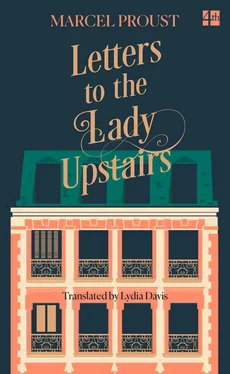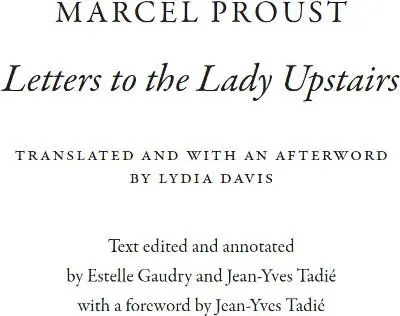
4th Estate,
An imprint of HarperCollins Publishers
1 London Bridge Street
London SE1 9GF
www.4thEstate.co.uk
First published in Great Britain by 4th Estate in 2017
First published in the United States by New Directions in 2017
First published in France as Lettres à sa voisine by Éditions Gallimard in 2013
Translation and afterword copyright © 2017 by Lydia Davis
Proust letters and critical apparatus copyright © 2013 Éditions Gallimard
Cover credit © Jo Walker
Published by arrangement with Éditions Gallimard.
4th Estate is grateful to Éditions Gallimard for providing the facsimiles and photographs, and for facilitating their use in this edition.
Fascimilies of Proust’s letters are courtesy of a private collection / Musée des Lettres et Manuscrits, Paris
Photograph of Marie Williams courtesy of Gérard Emler collection
A catalogue record for this book is available from the British Library
All rights reserved under International and Pan-American Copyright Conventions. By payment of the required fees, you have been granted the non-exclusive, non-transferable right to access and read the text of this e-book on-screen. No part of this text may be reproduced, transmitted, down-loaded, decompiled, reverse engineered, or stored in or introduced into any information storage and retrieval system, in any form or by any means, whether electronic or mechanical, now known or hereinafter invented, without the express written permission of HarperCollins.
Source ISBN: 9780008340063
Ebook Edition © 2017 ISBN: 9780008262884
Version: 2018-12-13
Contents
Cover
Title Page
Copyright
Foreword
A note on the French edition
A note on the English-language edition
Letter 1
Letter 2
Letter 3
Letter 4
Letter 5
Letter 6
Letter 7
Letter 8
Letter 9
Letter 10
Letter 11
Letter 12
Letter 13
Letter 14
Letter 15
Letter 16
Letter 17
Letter 18
Letter 19
Letter 20
Letter 21
Letter 22
Letter 23
Letter 24
Letter 25
Letter 26
Translator’s afterword
Floor plan of Proust’s apartment
Notes
Index
Works and Characters of Proust
About the Authors
Selected Translations of Lydia Davis
About the Publisher
The present collection forms a real novel in miniature, and is the result of a surprise discovery: twenty-three letters written to a certain lady of whom at first we knew nothing, along with three to her husband. She turned out to have been Marcel Proust’s neighbour on the third floor of 102 Boulevard Haussmann, one Mme Marie Williams, the wife of an American dentist. Doctor Charles D. Williams’s dental practice was two floors above the mezzanine – that is, directly above the head of poor Marcel. And that was the source of more than one drama endured by that noise-phobic.
We know very little about her. Born Marie Pallu in 1885, she married first, in 1903, a certain Paul Emler, who worked for a maritime insurance company. With him she had a son in 1904 whom Proust knew. She divorced in July 1908, the year in which she moved into the building on Boulevard Haussmann. The dentist was her second husband (though not the last). Through Proust’s letters, she appears to us like a heroine in a Maupassant novel, perhaps Our Hearts , for instance – we know that that novel was inspired by Proust’s friend Mme Geneviève Straus, also a friend of Mme Williams, who, oddly, resembled her, as she also resembled the courtesan Laure Hayman, a model for Proust’s character Odette (as though, with her, Proust were testing the theory according to which one always loves the same type of woman).
We know what Proust’s housekeeper Céleste Albaret said about the couple: on the floor above, ‘there was that extraordinary man Williams, the American dentist. […] Williams was a sports enthusiast and went off every Saturday with his chauffeur to play golf. He had married an artist, very distinguished, very perfumed, who was a great admirer of Monsieur Proust and had told him so in her letters. I recall that she played the harp. Her apartment was on the third floor, above her husband’s office. M. Proust’s opinion was that they formed a “disparate” couple. I don’t think he knew Mme Williams, but they corresponded and I know that he rather liked her refined way of expressing herself in her letters.’ 1
In this epistolary novel, the two correspondents compete in style: ‘Through a grace of generosity – or a play of reflections – you lend my letters some of the qualities of your own. Yours are delicious, delicious in heart, spirit, style, “talent”,’ writes Proust to Mme Williams, whose letters we do not have (as we do not have those of others of Proust’s correspondents, pages that were no doubt the victims of some sad auto-da-fé). What is intriguing is that these letters were exchanged between neighbours, from one floor to the other, sometimes even via the post. In each of them, Proust deployed all his charm towards Mme Williams, his sparkling humour, his cultivation, his skill with a compliment. Beyond his desire to please a neighbour who had some control over the silence he so needed, he felt a real sympathy for this other recluse, a kind of affection, as though, invisible yet present, she played the maternal role of that other ailing woman, Mme Straus.
What were the letters about? The noise first of all, the work being done on the floor above, which tormented Proust during the hours when he was sleeping and writing. ‘How right I was to be discreet when you wanted me to investigate whether the morning noise was coming from a sink. What was that compared to those hammers? “A shiver of water on moss” as Verlaine says of a song “that weeps only to please you”.’ In fact, Proust set each of his remarks within a humorous comparison that also achieved one more degree of art. For everything makes noise, even painters, who sing like a certain famous tenor: ‘Generally a painter, a house painter especially, believes he must cultivate at the same time as the art of Giotto that of Reszke. This one is quiet while the electrician bangs. I hope that when you return you will not find yourself surrounded by anything less than the Sistine frescoes …’
Music was also one of his subjects, because Mme Williams loved music and played the harp (perhaps also the piano): ‘Clary told me what a great musician you were. Will I never be able to come up and hear you? The Franck quartet, the Béatitudes , the Beethoven Quartets (all music that I have in fact here) are the objects of my most nostalgic desire.’
Proust, who described the hawthorns or the young girls in flower, admirer of Parsifal , with its flower-maidens and its ‘Enchantment of Good Friday’, placed flowers at the heart of his friendship and his correspondence. He sent bouquets to the young woman, and he delivered a dazzling speech on autumn roses in poetry. He was aware of being heir to the literary tradition of the language of flowers. He felt that ‘all women are tinted with the blood of roses’. 2They recur in the title of the second volume of In Search of Lost Time , which Proust was just then writing. He demonstrated his knowledge of poetry yet again in creating a pastiche, from memory, of the whole of the once celebrated sonnet by Félix Arvers (cited in Search ). It is amusing to see that in The Guermantes Way Proust attributes this taste for quoting poetry to the footman Périgot, who, writing to peasants ‘whose stupefaction he anticipated […], intermingled his own reflections with Lamartine’s verses, as though he were saying: time will tell, or even: hello’.
Читать дальше






![Marcel Proust - In Search of Lost Time [volumes 1 to 7]](/books/579170/marcel-proust-in-search-of-lost-time-volumes-1-to-thumb.webp)







